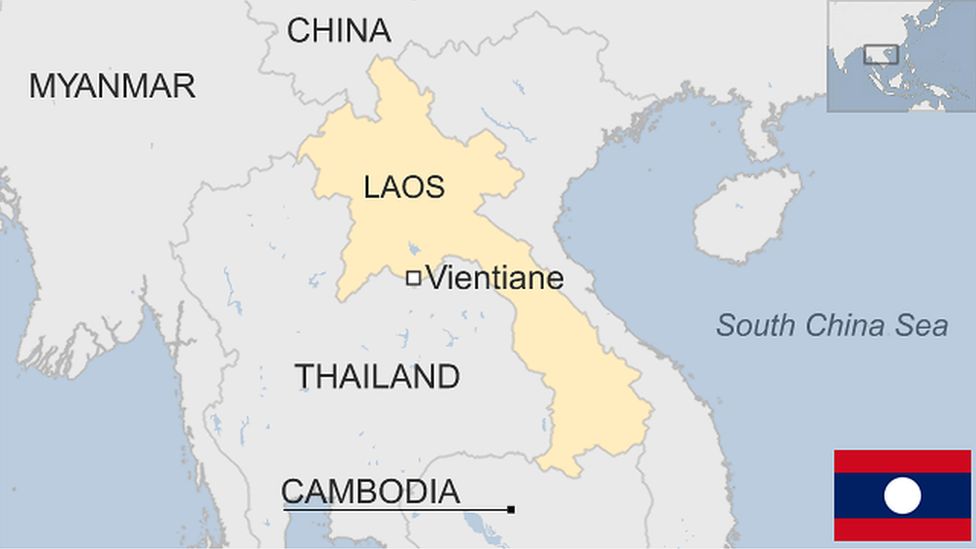Laos country profile
- Published

Laos is one of the world's few openly communist states. It is a one-party state and the general secretary of the Lao People's Revolutionary Party holds ultimate power and authority over state and government.
A French colony until the 1953, the power struggle which ensued between royalists and the communist group Pathet Lao also saw the country caught up in the Vietnam War. Communist forces overthrew the monarchy in 1975, heralding years of isolation.
After the fall of the Soviet Union in the 1990s, Laos began opening up to the world. But despite economic reforms, the country remains poor and heavily dependent on foreign aid.
Most Laotians live in rural areas, with around 80% working in agriculture mostly growing rice.
Laos plans for hydropower to become its biggest source of revenue. But its neighbours Vietnam, Thailand and Cambodia have all raised concerns about the environmental impact of its dam-building projects along the Mekong River which they jointly share.
- See more country profiles - Profiles by BBC Monitoring
LAO PEOPLE'S DEMOCRATIC RFEPUBLIC: FACTS
- Capital: Vientiane
- Area: 236,800 sq km
- Population: 7.7 million
- Language: Lao
- Life expectancy: 66 years (men) 70 years (women)
LEADER
President and General Secretary of the Lao People's Revolutionary Party: Thongloun Sisoulith
Thongloun Sisoulith was elected the Lao People's Revolutionary Party's general secretary, and thus effective leader of Laos in January 2021. He is the first civilian with no military background to be general secretary.
MEDIA
The ruling LPRP exerts tight control over the media and the government owns most mainstream outlets.
Use of social media, particularly Facebook, is widespread. But press freedom bodies say the authorities monitor usage for content deemed negative and individuals have been punished for posting such material.
TIMELINE
Some key dates in the history of Laos:
13th Century - Kingdom of Lan Xang, a million elephants, is founded by prince Fa Ngum who had been exhiled by his father from the Khmer Empire. He makes Theravada Buddhism the state religion.
1637-1694 - King Sourigna Vongsa rules for 57 years - seen as Lao's " Golden Age". After his death the country splits into three.
1763-1769 - Burmese armies overran northern Laos and annexe Luang Prabang.
1777 - Southern Laos comes under Thai rule.
1893 - Laos becomes a French protectorate until 1945, when it is briefly occupied by the Japanese towards the end of World War Two.
1946 - French return following the surrender of Japan.
1950 - Faced with an increasingly difficult war against the Viet Minh across much of French Indochina, France grants Laos semi-autonomy as an associated state within the French Union.
1954 - Laos gains full independence as a constitutional monarchy as French withdraw following defeat at the Battle of Dien Bien Phu by the Viet Minh.
1960 - Fighting breaks out between the Royal Lao Army and the communist North Vietnamese and Soviet Union-backed Pathet Lao forces, leading to civil war.
1960s - The United States intervenes in the region in a bid to prop up its ally South Vietnam against North Vietnamese and Viet Cong attacks. Laos is subject to extensive bombing the US attempts to destroy North Vietnamese sanctuaries and to rupture the supply lines known as the Ho Chi Minh trail.
1973 - Vientiane ceasefire agreement divides Laos between the communists and the royalists.
1975 - The Pathet Lao - renamed the Lao People's Front - seizes power and replaces the monarchy with a communist government.
1979 - Food shortages and the flight of hundreds of thousands of refugees to Thailand leads the government to modify its approach.
1986 - Encouraged by President Gorbachev's changes in the USSR, Laos introduces market-oriented reforms.
1994 - "Friendship bridge" over the Mekong linking Laos and Thailand is opened.
1995 - US lifts its 20-year aid embargo.
1997 - Laos becomes a member of Asean, the Association of Southeast Asian Nations.
2000 - Series of bomb blasts hits Vientiane; authorities blame anti-government groups based abroad. Celebrations of 25 years of communist rule.
2012 - Laos approves plans to build a massive dam at Xayaburi, on the lower Mekong river, despite opposition from environmentalists and neighbours Cambodia and Vietnam.
2013 - Becomes a member of the World Trade Organisation (WTO).
2016 - Barack Obama becomes the first sitting US president to visit Laos.
Related Topics
- Published25 August 2023
- Published5 April 2023
- Published22 August 2023
- Published22 August 2023
- Published26 May 2023